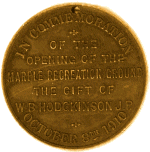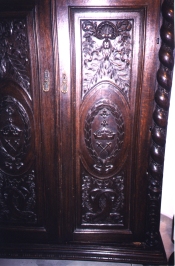Hollins Mill - Disappeared without trace?
|
Hollins Mill - Disappeared without trace? |
|
This article, by Peter Clarke, appeared in the December 2000 issue of the Romiley and Marple Mail in our regular feature "Local History & Heritage with the Marple Website" This reproduction of the article includes a number of pictures that were supplied to the Mail but not included, presumably due to space constraints. |
![]()
|
|
Disappeared without trace?
The Marple of the 1820's was essentially what it had been for centuries, a collection of small farms and hamlets with a population of approximately 2000. Since before the turn of the 18th century its neighbour, Mellor, had been becoming more and more industrialised with a number of mills appearing, not least Samuel Oldknow's 'Mellor Mill' which was at the time of its completion in 1793 the largest cotton mill in Europe.
It was not until the 1830's that Marple was to get its own 'Palace for King Cotton'.
Hollins Mill
The Hollins Mill was built by Charles Warmsley
in 1830 but later, in 1859, it came into the possession of the Carver family who
were to have a huge effect on the development of the Marple area. The Carver
twins, John and Thomas bought the mill in partnership with Samuel and Edwin
Hodgkinson, using a loan of £15,000 from their father William Carver, who
believed that the family should diversify from their carrying business. It would
appear that the Hodgkinsons had experience in the yarn business and indeed for
the first six years the business was known as 'S. Hodgkinson Company'.
|
|
The mill originally stood on land that is now occupied by the Hollins Shopping parade, and the Coop Superstore and in its heyday it dominated the skyline of Marple from whichever direction you cared to look. The main body of the mill stood 5 storeys high but the weaving sheds and offices more than trebled this area. It even had its own arm of the canal which was used to deliver raw materials and ship out the finished products.
For over a hundred years Hollins Mill was the largest employer in the district and virtually every family had somebody employed there. The Carver family themselves were, and still remain to this day, amongst the greatest benefactors Marple has known. They were responsible for the provision or construction of amenities that we now take for granted, e.g. the cinema (formerly The Union Rooms, a place of religious worship, Working Men's Club, coffee tavern and library), the Marple Reform Church, and they also helped set up a Boy's Club and Gymnasium in what is now the Carver Theatre. Walter Hodgkinson JP, son of the Carver's partner Samuel gave, to the people of Marple, the land on which Marple Recreation Ground now stands, the laying out was paid for by Thomas Carver. When the 'Rec' was opened all the children of Marple received a medallion as a memento of the occasion. I, personally, know of only one of these still in existence although I am sure there must be many more still lying about the bottom drawers of the area.
|
|
IN COMMEMORATION |
 |
|
|
Today
What remains today of this major
influence on the way Marple developed? All that is left of the mill is a
partially submerged bridge at the rear of the cinema under which canal boats
used to shuttle to and fro with their cargoes, the canal arm long since filled
in. The mill itself was demolished in stages over a number of years. The
spinning area, the 5 storey portion which fronted Hollins Lane, was demolished
in 1957, the chimney being spectacularly brought down by 'Blaster Bates' in
October of that year. The final part of the mill, the weaving sheds, survived in
one form or another until 1988 when they too were demolished to make way for the
present Coop Superstore.
|
|
The Carver family, whose business interests had been gradually drawing them away, finally left Marple in around 1920 after donating their family home 'Hollins House' (now the Council Offices) and the land around it for use as Marple's War Memorial Park.
The bricks and mortar of the mill may have long since disappeared but the family who ran it are remembered still in the bequests and institutions that they left behind.
Acknowledgements to:
"Hollins Mill - The centre of
Marple" by Ann Hearle & Peter Bardsley.
"Gregs - The story of the
Albert Mills" by Peter O'Connell.
Gordon Mills - Aerial photograph of Marple.
|
A SAGGER MAKERS WHAT?????? It's not just the mill that has disappeared, the following are the names of just a few of the jobs that you could have been doing had you been employed there around 100 years ago: A Blow Major *The Skippy referred to was a man who made small skips or trollies out of willow. These were used in the mills for the collection of bobbins and various other articles. Many of the willow trees (grown specifically so that their branches could be used) were to be found around Hibbert Lane, later the site of the Willows School, (now the Ridge Danyers College). |
| Feedback from Readers |
After our first feature about the Marple Hall shutters we were contacted by 82 year old Mrs. Minnie Fox of Marple, who told us about a hall robe from Marple Hall that was purchased by her friend Mrs. Westrip many years ago. The hall robe is now owned by her friend's daughter Beth Pavlaki, who lives in Athens in Greece with her husband George.
As best as we can ascertain the hall robe was probably bought by Mrs. Westrip in the sale of 1929, when most of the contents of Marple Hall were sold off at auction by Henry Bradshaw-Isherwood. Beth has kindly sent us some photographs of the hall robe and told us what she knows of its recent history:
| "Sometime during the late 20's or early 30's my mother acquired an armoire, very beautifully carved with cupid's faces, shields and crossed swords. The wood is stained oak and the interior had a shelf at the top, presumably for hats. The underside held four brass hooks which swivelled to hang coats. She told me she had bought it in an auction of items of furniture being sold at that time. Well over the years it became part of our lives with its creaking doors but sadly it was kept in a very gloomy hall, where the carving could never be seen. A place to throw our coats. When my parents retired to Wales the hall robe went along. Finally I had it transported to Athens. This time it was no longer practical to use as a cupboard and it is now used as a glass and drinks cabinet. We have it in a corner of our sitting room, where it is greatly admired. It survived last year's earthquake minus a few broken glasses. More than a few people have shown an interest in buying it but I really feel it should stay in the family. It now has a wonderful smell of ouzo!" |
|
|
|
 |
If you have anything interesting relating to Marple's history to share with us and other R&M Mail readers we would be delighted to hear from you. If the lady reads this who rang about the Marple Hall water-colours painted many years ago by her neighbour, we are looking forward to hearing from you again soon.
Please get in touch using our contact us page if you have anything interesting to share.